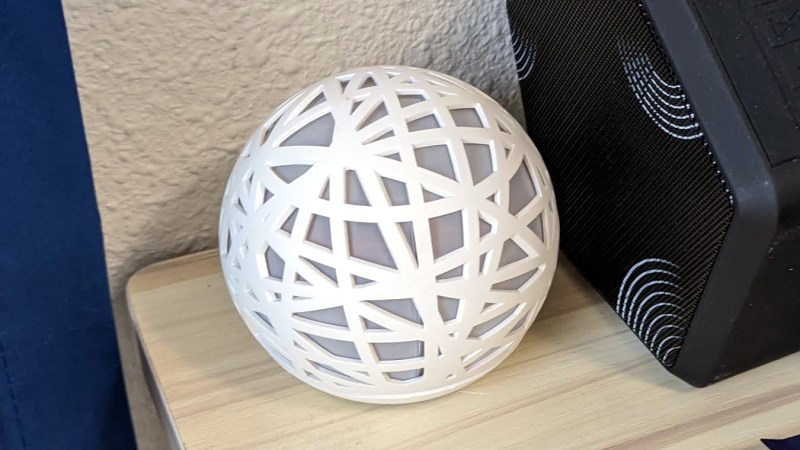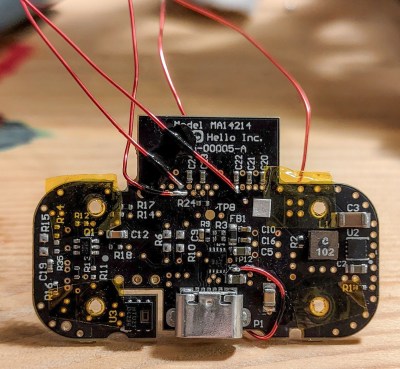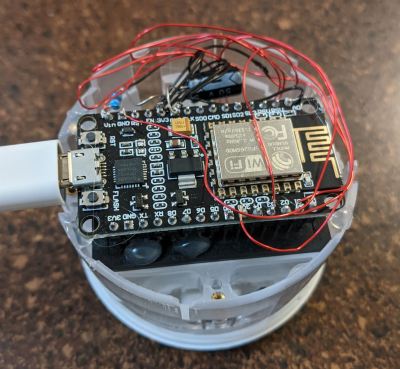If you have a Hello Sense sleep tracking device lying around somewhere in your drawer of discards, it can be brought back to life in a new avatar. Just follow [Alexander Gee]’s instructions to resurrect the Hello Sense as an IoT air quality data-logger.
In 2014, startup “Hello” introduced the Sense, an IoT sleep tracking device with a host of embedded sensors, all wrapped up in a slick, injection molded spherical enclosure. The device was quite nice, and by 2015, they had managed to raise $21M in funding. But their business model didn’t seem sustainable, and in 2017, Hello shut shop. Leaving all the Sense devices orphaned, sitting dormant in beautifully designed enclosures with no home to dial back to.
The original Sense included six sensors: illumination, humidity, temperature, sound, dust / particulate matter on the main device, and motion sensing via a separate Bluetooth dongle called the Pill. [Alexander] was interested in air quality measurements, so only needed to get data from the humidity/temperature and dust sensors. Thankfully for [Alexander], a detailed Hello Sense Teardown by [Lindsay Williams] was useful in getting started.
The hardware consisted of four separate PCB’s — power conditioning, LED ring, processor, and sensor board. This ensured that everything could be fit inside the orb shaped enclosure. Getting rid of the LED ring and processor board made space for a new NodeMCU ESP8266 brain which could be hooked up to the sensors. Connecting the NodeMCU to the I2C interface of the humidity/temperature sensor required some bodge wire artistry. Interfacing the PM sensor was a bit more easier since it already had a dedicated cable connected to the original processor board which could be reconnected to the new processor board. The NodeMCU board runs a simple Arduino sketch, available on his Git repo, to gather data and push it online.
For the online data display dashboard, [Alexander] found a nice solution by [Nilhcem] for home monitoring using MQTT, InfluxDB, and Grafana. It could be deployed via a docker compose file and have it up and running quickly. Unfortunately, such projects don’t usually succeed without causing some heartburn, so [Alexander] has got you covered with a bunch of troubleshooting tips and suggestions should you get entangled.
If you have an old Sense device lying around, then this would be a good way to put it some use. But If you’d rather build an air-quality monitor from scratch, then try “Building a Full-Fat Air-Quality Monitor” or “An Air-quality Monitor That Leverages the Cloud“.



















Were sleep trackers really any kind of useful? Seemed more like a fad.
there’s a lot of different reasons to study sleep and i have no idea what kind of features were widely available in consumer devices but i had a good time setting up a microphone by my bed to see what i say in my sleep. turns out, it’s kind of a lot, and it’s decently intelligible. even caught myself singing one night.
Sleep is kind of hard to quantify intuitively as you don’t remember your sleep environment and only see the effects bad sleep many hours later. My Sense data showed my sleep quality suffered in temperatures over 72’F. Without that objective data I would have just thought I don’t sleep well sometimes without making the link to temperature.
I have collected such data for nearly six years now (a lot now to think of it) and I’ve noticed similar tendencies and it has helped me make better decisions about how where and when I sleep.
My wife and I bought a Hello Sleep, and it was actually quite useful. We specifically didn’t want to wear any sleep tracking wrist devices, so the pillow-clip sensor worked well.
The device could monitor sleep activity, noise, light and air quality levels, temperature, humidity, and also had a ‘smart alarm’. It was the alarm we got most value out of it. It would wait until you were in a period of light sleep before setting the gentle morning alarm off, so you were always woken rested and not in the middle of a deep sleep. It was always really pleasant.
Secondary to us was the environment monitoring, which did often come in helpful to find out why we woke in the middle of the night. Spoiler: it was always the cat.
It’s a shame they’re gone. I re-purpose the devices into colourful wireless GlowOrb decorations that are hooked into Home-Assistant.
Try Sleep as Android’s sonar mode, just have to have a device near the bed. Don’t know how well it does with two people though.
Wonder how much of that 21 million they spent on designing and making the injection mold for that case and on effort to stack all the components in there. Looks somewhat fancy, but that has to have been extremely expensive compared to if it just had been a boring box.
From a quick look the whole thing looks completly overengineered. 5 PCB, 3 ARM, lots of sensors, …
Keep it simple!
Like the arm worn open source smart “watch” featured here, another round peg trying to be fitted into a square world. Gears are round for a reason, chips aren’t. What’s next? Round books and porthole big screens?